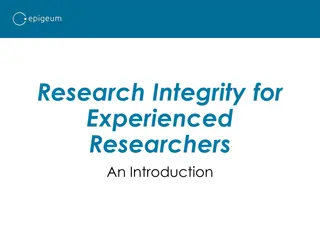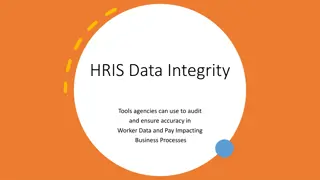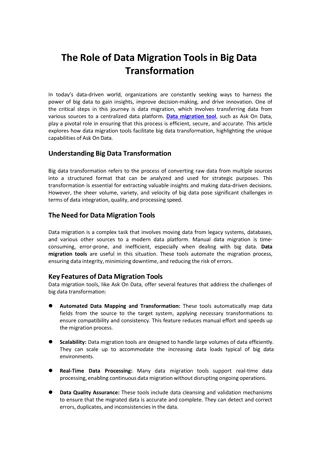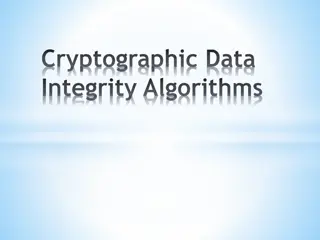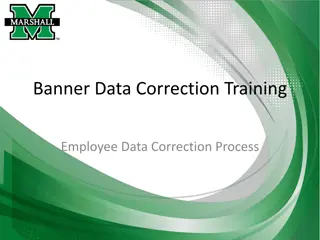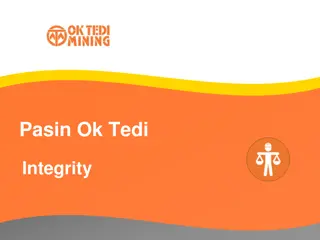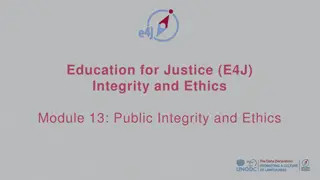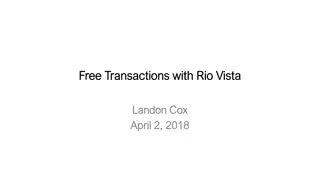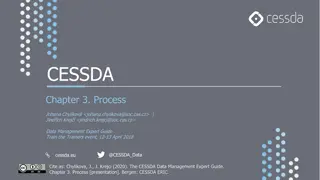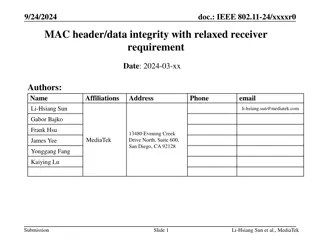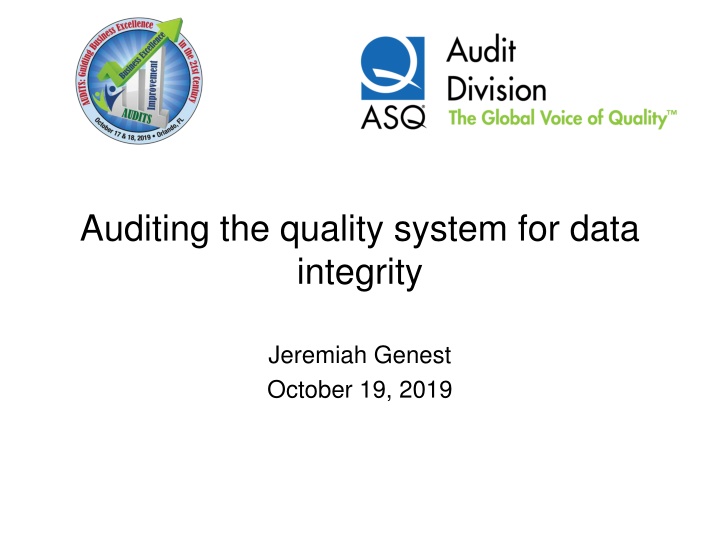
Data Integrity and Quality Systems
Explore the importance of data integrity, quality systems, and metadata in ensuring complete, accurate, and trustworthy data throughout its life cycle. Learn about technical and cultural hurdles in governing data integrity and how to apply mitigations effectively.
Download Presentation

Please find below an Image/Link to download the presentation.
The content on the website is provided AS IS for your information and personal use only. It may not be sold, licensed, or shared on other websites without obtaining consent from the author. If you encounter any issues during the download, it is possible that the publisher has removed the file from their server.
You are allowed to download the files provided on this website for personal or commercial use, subject to the condition that they are used lawfully. All files are the property of their respective owners.
The content on the website is provided AS IS for your information and personal use only. It may not be sold, licensed, or shared on other websites without obtaining consent from the author.
E N D
Presentation Transcript
Auditing the quality system for data integrity Jeremiah Genest October 19, 2019
By the end of this session, you will be able to: Apply a situational awareness to an organization Analyze the technical and cultural hurdles focusing on the core areas of governance, training, organizational controls, process and systems Create and utilize data maps to drive detection and remediation Apply mitigations to the common cultural hurdles 2019 ASQ Audit Division Conference: The DoubleTree by Hilton
Data Integrity is. . . . degree to which data are complete, consistent, accurate, trustworthy . . . throughout the data life cycle. Data should be collected and maintained in a secure manner, so they are attributable, legible, contemporaneous, original (or a true copy), and accurate. Assuring DI requires appropriate quality and risk management systems, including adherence to sound scientific principles and good documentation practices. . . . completeness, consistency, accuracy of data, which should be attributable, legible, contemporaneous, original or true copy, and accurate(ALCOA). DI is critical throughout the data life cycle, including creation, modification, processing, maintenance, archival, retrieval, transmission, and disposition of data after retention period ends. System designs & controls should enable easy detection of errors, omissions, and aberrant results throughout the life cycle. 2019 ASQ Audit Division Conference: The DoubleTree by Hilton
Data Integrity is Fundamental Digital Maturity Resources Information Systems Digitalization Workforce 4.0 Available and Qualified Holistic Value Network Integration and Traceability Quality 4.0 Organization and Processes Culture Holistic Control Strategy Lifecycle Management Communication Decision Making Lifecycle Management Data Integrity by Design 2019 ASQ Audit Division Conference: The DoubleTree by Hilton
What is Data? Static / Fixed Records Entry in batch records Laboratory test records Paper printouts from a system PAPER Electronic Dynamic Records Laboratory results Filtration results Chromatograms Recipes / settings Computer stored records Data Integrity applies to both Paper data (static records) can t replace electronic data (dynamic records) when electronic exists (e.g., PDF copy of report from Mfg equipment or manual recording from a display ) 2019 ASQ Audit Division Conference: The DoubleTree by Hilton
What is Metadata? What is Metadata? METADATA METADATA Data that describe attributes of other data, and provide context and meaning (data about data). Describe structure, data elements, inter- relationships and other characteristics of data. Permits data to be attributable to an individual. Can be any attribute that expands information related to the data. DATES: 14 Mar 19 TIME: 07:34 UNITS: g/L ID #: 0123 BR- 2019 ASQ Audit Division Conference: The DoubleTree by Hilton
Metadata examples 8.91 x10 6 8.91x106 vc/mL 01Jul2019 08:02:02 performed by: Dwight.Schrute 8.91x106 vc/mL 8.91x106 vc/mL 01Jul2019 08:02:02 8.91x106 vc/mL 01Jul2019 08:02:02 performed by: Dwight.Schrute Method: CHOBEETS1 Method revision history System setting changes Testing into compliance Manual recording of electronic process does not reconstruct entire process. 2019 ASQ Audit Division Conference: The DoubleTree by Hilton
Audit Trails Audit Trail review enables data reconstruction. Adhere to review frequency specified by Regulations, for example in GMP: 211.188: review after each significant step in manufacture/processing/packing/holding 211.22: review data before batch release - apply same review frequency for audit trail Risk-based approach based on process, data criticality, control mechanisms, and product impact. Reliability of review must be proven. Not an IT thing Audit trail review of electronic record analogous to cross-outs on paper record. Requires both process and capability understanding. 2019 ASQ Audit Division Conference: The DoubleTree by Hilton
Audit Trail Review Routine / data audit trail review: performed during routine data review processes. During test record or batch record review Identifying the steps in the process of generation of the results Periodic audit trail review: performed to ensure Audit Trial is configured correctly and administrative activities are being performed per the appropriate SOP. Identify administrative activities Evaluate validated state of a system 2019 ASQ Audit Division Conference: The DoubleTree by Hilton
Audit Trails Sometimes called Event Logs, User Events, System Logs, Parameter History etc. Provide full story for reconstructing data Things you might find: Changes to user permissions Changes to values Changes to parameters / settings Testing into compliance Repeated runs Different users performing tasks than documented on records 2019 ASQ Audit Division Conference: The DoubleTree by Hilton
ALCOA+ 2019 ASQ Audit Division Conference: The DoubleTree by Hilton
Attributable Information is captured in the record so it is uniquely identified as executed by originator. Data must be attributable to the person or system generating the data, or performing an activity. Users shall choose passwords that are not obvious and are sufficiently complex that the password cannot be easily guessed by a colleague. Users shall keep their passwords secret from other users, and if they do keep a record of their password it must be in a secure location not accessible to others. Ensuring data is attributable can be complicated when an automated process is started by one shift worker and continues to run autonomously through other shifts under the supervision of other operators. Clear timesheets, or similar records, are needed to document the shift changes, and to maintain a record of which operators made interventions to the process during that extended operation. PAPER RECORD Initials / Date DKS 01Jul19 Hand Written Signature Dwight K. Schrute 01Jul19 ELECTRONIC RECORD Log-on User ID dwight.schrute 01Jul2019 Electronic Signature Dwight Schrute 01Jul2019, 13:01:01 EST 2019 ASQ Audit Division Conference: The DoubleTree by Hilton
Legible Requirements that data are readable, understandable and allow a clear picture of sequencing of steps or events so all cGxP activities conducted can be fully reconstructed by record reviewers throughout records retention period. Where a user is required to record a reason for change, for example in an audit trail, the reason recorded should clearly explain why the change was necessary and reference any supporting documentation such as an approved change request. This will facilitate reconstruction of the event and understanding of the motivation for the change such that a reviewer or auditor can decide if the change was procedurally or scientifically justified. Any errors in recording data shall be conserved in the original documentation, with a clear identification of the error or reason for change; the original data must remain visible; and the correct data must be recorded along with the user name, date, and time. Where entries are handwritten, they should be clear and readable by anyone, and written in indelible ink. Audit trail requirements are inherent within Attributable, Legible, and Complete. PAPER RECORD ELECTRONIC RECORD No Pencil Enforce Saving Indelible Ink No Over-Writing or Deletion No Correction Fluid No Annotation Tools Correction with Single Line Cross-Out that is Initialed, Dated, and Explained Changes Captured in Audit Trail, All Original and Modified Data Must Be Visible 2019 ASQ Audit Division Conference: The DoubleTree by Hilton
Contemporaneous Documentation of action at the same time it is observed or occurs . Users shall record data at the time it is generated and shall use the time shown on a networked computer or official company-maintained clock to provide the date and time if manually recorded (instead of using a personal wristwatch that may not be synchronized to company time). Users must always record the current date and time, irrespective of when the task should have been completed. PAPER RECORD ELECTRONIC RECORD Record Time and Date Date and Time Locked Attribute User Login and Date Time Stamp to Activity Sign Bottom of Page when Complete No Back Dating Records Saved Immediately Completion of Step Must Precede Progress to Next Step No Pre-completion of Records 2019 ASQ Audit Division Conference: The DoubleTree by Hilton
Original Original: The first or source capture of data or information and all subsequent data required to fully reconstruct conduct of activity including all associated metadata. Original record: Data as the file or format in which it was originally generated, preserving the integrity (accuracy, completeness, content and meaning) of the record, e.g. original paper record of manual observation, or electronic raw data file from computerized system. Data must be recorded directly into the authorized media. Users must record the first reading/measurement/calculated result, even where that value may be deleterious to the overall pass/fail status of the task. In the event that a user makes an error in completing a paper form or the form sustains damage in some way, the original paper form must be kept and cannot be discarded for a new form. Users must not take unauthorized copies of blank controlled forms with the intent of using them to replace any forms containing mistakes or undesirable results. Consideration should be given to incorporating watermarks and iridescent inks into forms to allow easy detection of unauthorized photocopying, over and above the procedural requirement for controlled issuance of forms. All documents should have a unique identification number, a form design that provides sufficient space for manual data entries, and make clear what data should be recorded and where. 2019 ASQ Audit Division Conference: The DoubleTree by Hilton
Original, continued Users must take care to preserve the original record, which would be the first location in which the information is recorded. For example, when manually writing down a balance reading the user must write it directly into their laboratory notebook or controlled form; a temporary recording onto a scrap of paper would make the scrap of paper the original record. All unused forms should be accounted for, and either defaced and destroyed, or returned for secure filing, with access to the (electronic) templates strictly controlled. Reviewers need to ensure they review the original records (or true copies thereof) including complete data. For dynamic data, the review should be done on the electronic data. PAPER RECORD ELECTRONIC RECORD Original Laboratory Notebook Original Chromatographic Data Logbook Audit Trail Balance Printout SAP Transaction Batch Record Electronic Equipment Data 2019 ASQ Audit Division Conference: The DoubleTree by Hilton
Accurate Data are correct, truthful, valid and reliable Users must rigorously follow written procedures governing their daily tasks and apply their training and skills to ensure that any data they generate is accurate. Care must be taken when manually writing or typing data to avoid transcription errors; self-checking of recorded or calculated data should be encouraged as part of routine working practices. In a laboratory environment this would include ensuring that equipment is calibrated and has the correct range and resolution for the intended measurements, that any reagents are within their expiry date, and that the test method and parameters are appropriate for the sample under test. In a clinical study the data must represent the real facts of the study, including accurate measurement of patient vital signs using calibrated blood pressure monitors, weigh scales, etc., and recording all responses. 2019 ASQ Audit Division Conference: The DoubleTree by Hilton
Complete Complete data relies on the user collecting and preserving all of the original data, derived data and results, metadata, and audit trail. Complete data requires the user to collect all records created or modified and not selecting only those records that meet specifications. Where multiple results are generated, the user must ensure that all results are formally addressed and reported. All operator actions must be recorded and maintained. The user must follow a clearly defined procedure to invalidate any results where there is sound scientific justification to do so, and must preserve all data, metadata, and audit trail entries related to the results, invalidated or not. A user must not delete electronic GxP data or destroy GxP paper records that are necessary to preserve the data, content or meaning as required under the predicate rules. Such data can only be deleted at the end of the 2019 ASQ Audit Division Conference: The DoubleTree by Hilton
Consistent Due care and attention must be given to any task undertaken by the user that generates data. The user may develop a consistent set of key phrases for reasons for change and error corrections to facilitate searching and reviewing. Users reviewing data must first determine can the data be trusted before making an approve/reject decision on the data as compared to its governing specification. This may involve examining audit trails and metadata, verifying operational sequences using the time stamps recorded, searching for duplicate or modified data, and checking the original data upstream of the activity 2019 ASQ Audit Division Conference: The DoubleTree by Hilton
Enduring Data must be recorded in a permanent, maintainable form for the retention period. Procedures should confirm that archived data, including relevant metadata, is available and human readable. Any data created electronically must be stored in a location that is backed up. It is not recommended to store GxP data on local computer hard drives. Users of controlled forms and worksheets must take care to protect the forms throughout their use and then to return them to the original issuer or archivist for safe archival for the retention period. 2019 ASQ Audit Division Conference: The DoubleTree by Hilton
Available A user must ensure that all of the data they have generated, whether recorded on paper or electronically, is filed in a logical and labeled secure location for ease of retrieval. It is good practice that filenames for electronic data are chosen to reflect the contents of the file to facilitate search and retrieval. 2019 ASQ Audit Division Conference: The DoubleTree by Hilton
Data Integrity is. External Environment Internal environment Data Lifecycle Good Documentation Practices 2019 ASQ Audit Division Conference: The DoubleTree by Hilton
Falsification Exists When To Break Managerial pressure or financial gains are two main drivers to push people to commit fraud. Setting unrealistic objectives such as stretch goals, turnaround time or key performance indicators that are totally divorced from reality especially when these are linked to pay or advancement will only encourage staff to falsify data to receive rewards. These goals coupled with poor analytical instruments and methods will only ensure that corners will be cut to meet deadlines or targets. Management must lead by example not through communication or establishing data governance structures but by ensuring the pressure to falsify data is removed. This means setting realistic expectations that are compatible with the organization s capacity and process capability. Staff need to understand how their actions can impact the health of the patient. Ensure individuals know the importance of reliable and accurate data to the wellbeing of the patient as well as the business health of the company. To commit fraud people must either have an incentive or can rationalize that this is an acceptable practice within an organization or department. The opportunity to falsify data can be due to encouragement by management as a means of keeping cost down or a combination of lax controls or poor oversight of activities that contribute to staff being able to commit fraud. Implement a process that is technically controlled so there is little, if any, opportunity to commit falsification of data. 2019 ASQ Audit Division Conference: The DoubleTree by Hilton
Human error built into investigations 2019 ASQ Audit Division Conference: The DoubleTree by Hilton
Decision Tree Data Integrity Event Decision Tree Event Event Notification Issue is due to a GxP related to electronic data/ paper data (it includes audit trail, raw data, metadata, true copy? Holistic system overview for events Not a Data Integrity Event NO Y NO Considerations and Examples: Record is signed, it indicates who did the action? A generic account was used to record activity? There is no possibility to identify who did the actions? Audit trail did not track who execute the action? There is no link between paper record and esign Activity was recorded by a different person with respect to the action and/or there is no SOP that manages this aspect. Attributable Data Is not attributable to who generated data? Attributable Attribution of actions records should occur, as appropriate, through the use of: initials (user ID in Computer Systems); handwritten signature (eSign when applicable) Look for trends Legible (Enduring) Considerations and Examples Corrections have been made on the document without justifications or made in a non-compliant manner (obliteration, whiteout, etc.), missing signature/date that cannot be reconciled. Document missing pages or is not complete (i.e. Batch Record does not contain all the requested attachments) Data is not legible or not preserved (i.e. faded thermal paper and a true copy was not executed) Audit Trail does not exist, it is not possible to reconstruct the whole history Back up of data does not exist, nor a mitigation action Original data it is not retrievable from the computer system Electronic data were deleted/overwritten/lost, a back up is not available It is not possible to read the data, data have been manipulated/deleted/ disrupted/lost. Data cannot be considered legible. It is not possible to reconstruct the activity executed. The reviewer cannot reconstruct the whole history. Considerations and Examples: Procedures do not describe in a clear way how to record data and make corrections It is not possible to have a time-stamp from the system Data is saved in temporary memory, not in a permanent way Date & Time can be changed by a user with generic profile Date & Time have to be synchronized with the server time An SOP should be available on how to execute a true Copy from an original record document The file is a copy that does not preserve the dynamic nature of the electronic record Audit Trail is not activated on the System Audit Trail is missing for a timeframe Contemporaneous Data was recorded in another timeframe so that it cannot be considered contemporaneous ? Data is not original, there is no possibility to reconstruct the whole history? Nor is a True copy available of the original document/record; Date & Time change on the Computer System is not protected Original Considerations and Examples: Systems are qualified/ periodically maintained, Validated, Calibrated? Systems undergo a periodic review? Is there in place a validation package for the Computer Systems that tracks the processing, storing, archiving, and generation of data? Computer Systems are validated in order to ensure that data are valid, consistent? If there is an interface between systems to transfer data, was this interface part of the validation effort? Analytical Methods were validated? GxP data and record undergo a routine review which includes meta data? Was there data loss? Data is not retrievable anymore? Systems not validated/calibrated/ qualified were used to produce data? SOP Instructions were not followed so that it is not possible to reconstruct the whole history Accurate 2019 ASQ Audit Division Conference: The DoubleTree by Hilton Data Integrity Event Yes
Build the Quality Culture 2019 ASQ Audit Division Conference: The DoubleTree by Hilton
Risk Assessment Manufacturing/Facilities Process / Materials Laboratory Quality Systems Ranking Data Process / Materials Data Data Final Formulation & Finished Product, Stability Capture & Purification CPP (including well controlled) Deviation, Regulatory Data 5 C of A, Release Media, Buffer, Cell Culture & Utilities KPP, cleaning or sterilization critical parameter Purity, Identity, Microbial (not C of A or release) Intermediates & Raw Materials 3 CCR, CAPA, SOP All other (e.g. Reagents, Utilities) Training, GRT, Other 1 Other Other All other testing The risk-based approach will utilize three factors, data criticality, existing controls, and level of detection Controlled Access/ Different User levels No access control Controlled via room access or procedural controls Access controlled w/ limited user levels or generic accounts Access controlled w/ sufficient user levels Ranking Signature Data Archival 4 None No Data Archival 3 Paper Signature Paper Archival Paper Signature & Witness/Verify (if applicable) Paper & Electronic Archival 2 Automatic Electronic Archival Audit Trail (exists/reviewed) Does not Exist 1 Esign Ranking 4 Review/ Approval None Review/Approval performed but only final result (not raw or meta data) OR No verify or witness considerations Verify or Witness considerations AND some Raw/Meta Data Review/Approval performed but not all data or not all signatures Paper Audit Trail created & reviewed 3 2 Electronic Exists & Reviewed Electronic Exists & Reviewed/Flags Suspected Data Verify or Witness considerations as well as manager/quality approvers Raw/Meta data 1 2019 ASQ Audit Division Conference: The DoubleTree by Hilton
Data Integrity is a result of many factors Data Integrity Controls Operational Quality Culture Code of Conduct Data Review Job Aids OJT Human Performanc e Technical Organizational Infrastructure & architecture Security Access controls Storage Backup Archival Audit trails Interfaces Enterprise systems Business continuity & disaster recovery Quality Mgmt System Policies, Procedures and Directives Good Documentation Practices Training & awareness Validation Change Management QRM Exceptions & investigations Audits Contract & vendor management Organizational Controls Operational Controls Technical Controls Data Integrity Data Governance
Data Map Example Assay Phase Dilution info from SOP Prep/Input Manual Data Copy Label Printed and Put on Sample LIMS Data & Dilution Info entered LIMS Sample Logged in Manual Data Copy Data Copy Data Copy Data Creation Bench Sheet (Attachment 2: Worksheet 2), Perform Dilutions Manual Data Copy Instrument Data Copy Manual Data Copy Manipulation LIMS Performed and review checklist including event log & trends Data Manual Data Copy Manual Data Edit Assay Sheet Results Sheet LIMS performs Calculations Manual Data Edit (LOQ)/ Data Copy Data reviewed w/ data package, event log, trends Data Edit LIMS Data Copy Manual Data Copy (Class A inst info) Data Store Data Use Document Management System Logbook CofA Data Store Data Copy Data Copy Data Store Data Store Data Store Data Store Data Storage Data Package including Checklist Archived (Lock box and Locked Cabinets) Logbooks archived Data Archived Data Archived Data Archived Data Archived 2019 ASQ Audit Division Conference: The DoubleTree by Hilton
Data Map Data process maps look at the entire data life-cycle from creation through storage (covering key components of create, modify and delete) and include all operations with both paper and electronic records. Data maps are cross- functional diagrams (swim-lanes) and have the following sections: Prep/Input Data Creation Data Manipulation (include delete) Data Use Data Storage 2019 ASQ Audit Division Conference: The DoubleTree by Hilton
The 5 Questions Do you have your source data? Do you know where your data is throughout the lifecycle? Is it readily retrievable, secure from inadvertent deletion or modification and backed up by a validated process? Have you defined the source data appropriately? (not paper for electronic systems) Do you review your source data? Is the source data reviewed through the system? (not paper for electronic systems) Does your review include meaningful metadata? Are audit trails reviewed with the data review? Are parameters / settings reviewed? Are user settings and access reviewed? Do you have proper segregation of duties? Do users have individual logins? Do users have the appropriate role for their job function and are permissions appropriate? Are System Administrators separate from everyday users and limited to the least number of users? Have you validated your systems for intended use? Has system been validated for its use? (all features, ranges and settings that will be used in the day to day activities) Are controls in place for secure date and time stamps and synchronization? 2019 ASQ Audit Division Conference: The DoubleTree by Hilton
An Audit Checklist Concept Question Ask Operator: what level of access do you have? Can you delete data, change programs, change date/time? Try to change date/time on system, including time zone while under an operator login. Who has admin access? Are they independent of persons responsible for the content of the records generated by the system for regulated purposes? Is a periodic review of user access performed? Are accounts deleted/disabled? Check Recycle Bin on windows desktop no GMP data should be in there. Are the electronic records for this system being maintained (e.g., backed-up, archived) in a secure manner? Are the electronic records for this system maintained / archived in a manner that preserves their content and meaning (i.e., as verified true copies of the original electronic data set to include metadata and with provisions for software to view the data)? Has the archival process been validated/ verified? User Access User Access User Access User Access Archive Archive Archive Archive Ask to see the audit trail. Can they pull it up? Ask supervisor: What do they review? SOP on when they review? Can you trace actions to personnel? Audit Trail 2019 ASQ Audit Division Conference: The DoubleTree by Hilton
Audit Checklist Concept Question Are supervisory or quality personnel reviewing the electronic records and relevant metadata (such as audit trails) for this system or are supervisory personnel merely reviewing the final printout? Do actions in logbooks/on paper match actions in the system? Did the person who ran the run record it in both places? What happens if a test fails? Where does the electronic or paper record go? When can you retest? Who has to approve a retest? If there are manual entries during any process, is there a witness or verify step? How do they ensure accuracy? If a printout is used, is it verified against the electronic? Or is the printing process validated? Originality Traceability Accuracy Accuracy Accuracy 2019 ASQ Audit Division Conference: The DoubleTree by Hilton
Quality Culture 2019 ASQ Audit Division Conference: The DoubleTree by Hilton
GEMBA Walks for Data Integrity Enabler for Cultural Change Role-modeling opportunity for leaders A way to empower personnel Opportunity for continuous improvement 2019 ASQ Audit Division Conference: The DoubleTree by Hilton
At the end of this session, you should be able to Apply a situational awareness to an organization Analyze the technical and cultural hurdles focusing on the core areas of governance, training, organizational controls, process and systems Create and utilize data maps to drive detection and remediation Apply mitigations to the common cultural hurdles 2019 ASQ Audit Division Conference: The DoubleTree by Hilton
Questions? 2019 ASQ Audit Division Conference: The DoubleTree by Hilton


